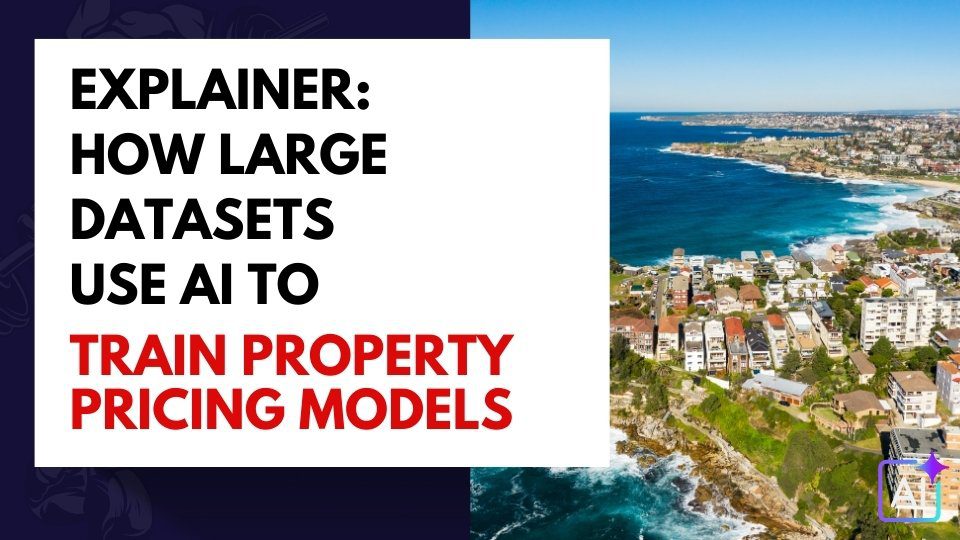AI Learning Centres:
- AI – Learn The Basics
- Get The Most From ChatGPT
- Branding in The Age of AI
- AI for Client Experience
- AI For Prospecting
- AI For Marketing
- AI For Listings & Ads
- Team Adoption of AI
- AI For PM
- AIO & Generative Search
- AI For Operations & Efficiency
- AI For Market Research & Analysis
- AI Ethics, Privacy & Compliance in Real Estate
Digital Marketing & Social Media Learning Centres:
Guides & Downloads

Explainer: How Large Datasets Use AI to Train Property-Pricing Models
A property-pricing model is computer software that looks at many facts about a home and its surroundings, then predicts a likely sale price.
The most common type is an Automated Valuation Model (AVM). An AVM copies the steps a valuer takes – finding similar recent sales, checking current listings, and weighing up the home’s features, only it does this in seconds with help from artificial intelligence (AI).
Where Does the Data Come From?
Sales and settlement records from state land titles offices
Current listings on portals such as realestate.com.au and Domain
Property attributes: beds, baths, floor size, renovations, energy rating
Location layers: school zones, transport, flood risk, noise maps
Market conditions: interest rates, auction clearance rates, consumer sentiment
These sources combine into a “big-data lake” that can hold millions of rows—far more than any person could study by hand.
How AI Learns From Large Datasets
| Step | What Happens | Why It Matters |
|---|---|---|
| 1. Collect & clean | Remove duplicates, fix missing or messy entries. | Dirty data leads to wrong prices. |
| 2. Create features | Convert raw facts into numbers the computer understands (e.g. “distance to CBD” or “noise score”). | Gives the model richer signals. |
| 3. Train the model | Run algorithms such as hedonic regression, decision trees or deep learning until the computer spots patterns linking features to price. | Finds relationships too complex for a human spreadsheet. |
| 4. Validate & test | Hold back recent sales, predict their prices, then compare with real results. | Shows if the model is accurate in the real world. |
| 5. Update regularly | Feed in the newest sales each day so the model stays in tune with the market. | Keeps estimates relevant during fast-moving cycles. |
CoreLogic’s well-known Hedonic Home Value Index follows this workflow, using hedonic regression to adjust for differences between homes.
Real-World Examples You’ll See in the Field
CoreLogic Hedonic Home Value Index – Tracks daily value shifts across suburbs and property types using hedonic regression and millions of settled sales. Useful for spotting trends and setting vendor expectations.
PropTrack AVM 3.0 – Blends AI sub-models, image scoring, and geospatial data to give instant estimates shown as the “realEstimate™” on realestate.com.au.
Noise-adjusted valuations – Recent studies layered aircraft-noise data over 3.7 million Victorian homes, proving how extra data sources can fine-tune price accuracy.
Why This Matters for Agents
Faster price conversations – Arrive at an appraisal with data-backed ranges in seconds.
Stronger vendor trust – Show the model’s evidence (comparable sales, photos, maps) to support your advice.
Early market signals – Daily index feeds flag turning points weeks before median reports update.
Time savings – Let AI crunch the numbers while you focus on relationships, negotiations, and service.
Limits & The Human Touch
AI can miss recent renovations, unique views, or emotion-driven buyer behaviour.
Data gaps in very small markets may widen the error margin.
Bias can creep in if past sales under-represent certain property types.
Your role: sense-check the estimate, add local stories, and explain outliers. The model is a starting point, not the final word.
Quick Checklist for Daily Use
Pull the latest AVM report before every listing presentation.
Check the confidence score—low scores mean you’ll need extra comparables.
Walk through the property to spot features the model can’t “see”.
Adjust the price range where needed and explain the reasons clearly.
Save the report as a baseline; after the sale, compare result vs estimate to refine your future pitches.
By understanding how large datasets feed AI-powered models, you can harness cutting edge pricing tools while still adding the local knowledge and personal insight clients value most.
Author – Ken Hobson.






